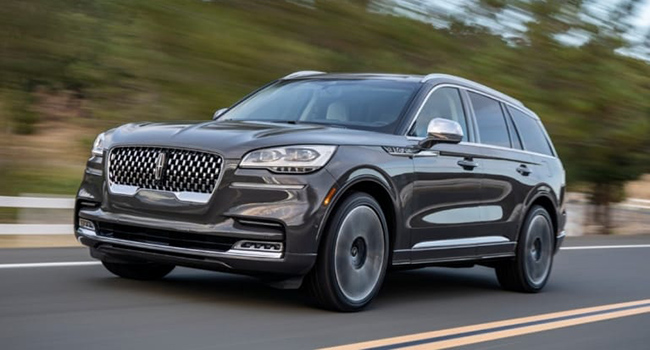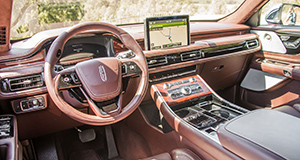
Lincoln has six models in its lineup and right near the top of the heap is the Aviator, a nicely-styled, luxury-laden mid-sizer that debuted in 2002 and is now in its second generation
 Much like General Motors with its Cadillac division, Ford has decided to funnel a substantial portion of its resources into its flagship Lincoln line.
Much like General Motors with its Cadillac division, Ford has decided to funnel a substantial portion of its resources into its flagship Lincoln line.
Over the past few years, we’ve seen a kind of renaissance from this previously low-key marque.
Lincoln has six models in its lineup, four of which are SUVs. Clearly, the powers that be at Ford have determined that this is where the money is in the North American car market.
And right near the top of the heap is the Aviator, a nicely-styled, luxury-laden mid-sizer that debuted in 2002 and is now in its second generation.
Technically classified as a mid-size SUV but feeling much larger, the 2020 Aviator is available in five trim levels, ranging in price from just over $51,000 to about $88,000. My Reserve version is somewhere in the middle of the group and, after the dust settles, is getting close to the top end.
In every respect, the Aviator is truly a luxury vehicle, with modern conveniences like heated/cooled seats, push-button power doors, heated steering wheel, four-zone heating/ventilation/air conditioning (HVAC), heated windshield wipers, rear window shades, leather interior, power rear tailgate, glitzy exterior “puddle” lighting, and on and on.
Ford hasn’t missed much when it comes to pampering the occupants of this big boy, and there aren’t many vehicles of this ilk that can top the Aviator when it comes to comfort and convenience.

The Aviator is truly a luxury vehicle, with modern conveniences like heated/cooled seats, heated steering wheel, four-zone heating/ventilation/air conditioning (HVAC), heated windshield wipers, rear window shades, and on and on
Power is delivered by a turbocharged 3.0-litre V6 engine mated to a 10-speed gearbox, with available all-wheel-drive, and piano-type shift buttons.
The Aviator will seat seven adults and purportedly tow up to 6,700 pounds.
A few observations:
The seats killed me on this car. Although they have multi-adjustable settings and can be heated or chilled, I just couldn’t get comfortable. This is a problem I’ve had with every Lincoln I’ve driven lately and it ruins what is an otherwise pleasant driving experience. Maybe it’s just me but I suffered when I drove this vehicle.
The push-button door levers are pointless and a waste of technology. They’re more trouble than they’re worth and if they were optional, I would definitely not choose them. There’s a manual override on each door, which should tell you something.
The interior is a busy place. The instrument monitor displays radio settings, HVAC control and so on, but also puts up bulletins regarding road conditions and/or upcoming delays. Handy and annoying at the same time.
Ford/Lincoln still have work to do with this transmission. It just doesn’t want to behave itself and lurches into gear during low-speed manoeuvres like parking. I got used to the push button shift buttons, however.
All kinds of power at your disposal here, some 400 horses, in fact. The V6 is lively, well-behaved and smooth in operation. Now, if the power train engineers could just get the transmission to properly match this engine, they’d have something. Ford has always excelled at engine design and this power plant is no exception.
The ride is a little too floaty for me. An SUV, regardless of its luxury trappings, should have a firm ride – this one doesn’t and kind of reminded me of a 1970s luxury sedan.
Plenty of cargo room. With all the seats folded flat, you’ll get some 77 cubic feet of storage capacity. This vehicle is not primarily intended to carry cargo but if you have to, it’s up to the job.
SUVs aren’t supposed to be paragons of styling, but the Aviator is a looker. I really like the two-box simplicity of it and it conveys a kind of muscular refinement. At first glance, you recognize that this is an upscale automobile and it has a presence about it that’s appealing without being over the top. The Aviator is the best-looking SUV on the market.
2020 Lincoln Aviator
Engine: 3.0-litre twin-turbocharged V6
Transmission: 10-speed automatic
Drive: rear wheel/all-wheel
Horsepower: 400 at 5,500 rpm
Torque: 415 foot pounds at 3,000 rpm
Base price: $69,000; as tested, $87,435
Fuel economy: 9.6 litres/100 km, combined rating, with premium gas
Some alternatives: Cadillac XT5, Infiniti QX80, Mercedes GLE, Acura MDX, Audi Q7, Jaguar F-Pace, Lexus GX. Porsche Cayenne, Volkswagen Atlas, Hyundai Palisade.
Ted Laturnus writes for Troy Media’s Driver Seat Associate website. An automotive journalist since 1976, he has been named Canadian Automotive Journalist of the Year twice and is past-president of the Automotive Journalists Association of Canada (AJAC).
The views, opinions and positions expressed by columnists and contributors are the author’s alone. They do not inherently or expressly reflect the views, opinions and/or positions of our publication.

